
Finding Your Audience with Facebook Ads on the Cheap
You’ve just started your business, or you feel like you’ve hit a peak. You’re wondering how to get more sales. One solution – Find your audience with Facebook ads. Does this sound absurd? Read on to find out how to use Facebook ads as a great way to find your audience.
Why Does An Audience Matter?
Unlike Google Ads, Facebook Ads are not targeted by keywords. Instead Facebook ads are targeted by audiences. Great news if you need to figure out your audience.
Why?
Facebook has tools to target distinct demographics and interests from within Facebook. How does this help you when starting out? You’ll have to keep reading.
Understanding your audience unlocks a vast amount of potential for your business.
Decrease Your Customer Acquisition Costs
It is natural to start advertising on gut instincts, or worse, a spray and pray strategy. Trust me, both are very expensive ways to get business. You’ll create content no one reads and pay for views or clicks for people that will never be customers. I’ve done it, don’t repeat my mistakes.
Second, you’ll lose important feedback about what you’re selling. Did you create the right product or service? Was the initial feedback correct?
By limiting your audience based on real data, you’ll increase engagement and lower your advertising costs. You want to sell to your potential customers and not everyone.
Better Content
When you know your audience it is easier to produce content that they will like. Creating content tailored for your audience is a virtuous cycle. You get more engagement, more organic reach, and better results for every channel.
Easier Keyword Research
No more guessing. Once you find your audience you know the content they want and the questions they have. You don’t have to spend tons of time researching keywords. You’ll know them already.
Crafting A USP
A USP is a unique selling proposition. Simply, why should someone buy your product or service? When you find an audience you understand their biggest challenges or desires. You develop your USP around that.
Now that we know some of the reasons finding an audience is important let’s see why you would run ads to find them.
Why Would I Run Ads To Find An Audience?
Makes no sense right? You run ads that target your audience. Running ads to find your audience is so backward.
Is it?
Traditional Ways Of Finding An Audience
There are several ways to find a target audience. They are tried and true.
Ask The Right Questions / Market Research
You need to have the answers about your target audience. Neil Patel has a perfect post on 6 questions to ask to define your target audience. This will take doing your homework. You will need to make sure you research your target audience to be able to answer these questions.
This will work. It takes time to do correctly. You’ll have to test content. You’ll need to survey customers. This strategy is extremely effective, yet time-consuming.
Use Existing Customers
This method doesn’t take a lot of work. Take your existing customers. Make a list. Send it to Facebook and create a lookalike audience. The downside to this is you lack the insight into the demographic information that makes it all work.
If you don’t have customers or a website this won’t work. Even if you do, but you have not firmly established your audience, you may be trying to sell to people that aren’t customers.
Research Your Competition
If someone buys from your competitor they may buy from you. That may be true. It may not be true, but it provides another way to build out an audience.
Competitive research is another strategy that takes time. You also spend more time looking outward instead of focusing on your business. It can work, but it needs to be balanced.
Is there another way?
Find Your Audience With Facebook Ads
It sounds insane that you would pay to find your audience. Imagine a world where you spend weeks or months on a static creative and copy and pay to put it in a magazine or on a billboard. That’s insane. Thankfully, we live in a digital world.
You’d be amazed what you can do for $25 running Facebook ads. The same could be said for paid search or YouTube. These modern marketing marvels enable you to create custom audiences. With a bit of knowledge and some strategic thinking you can begin to understand who your audience is and what messages resonate for your audience.
Yep, I said $25. Realistically you’ll be testing multiple segments, creative, and copy. So costs can be higher, but not exponentially. The more you already know about your audience the lower the amount of time and spend required.
Timeline also plays a part in costs. Moving faster requires more money.
I’m sure you have a sense of the people who would buy your product or service. That serves as a starting point from which to build. Let’s see how this strategy works.
Go Broad At First
Your goal is to get a sense of interest in your product or service at a high level. Don’t target all Facebook users. Start with what you know about your customers. Just make sure the ad you create matches the broadness of the audience. Let it run for a day with a $20 – $25 ad spend. Continue to run the ad to get additional validation of the broad audience as needed.
What you should target:
- Age
- Gender
- Location
- Broad Interests for Your Product or Service
For a small amount of money, you can begin to see interest in your product or service. You could continue to refine your copy and creative if key metrics like CPC, Engagements, or others aren’t good. Doing so will make sure you have something people are looking for.
Turn The Demographic Dials
Start to get more specific on demographics. Here you can test gender, smaller age ranges, and specific locations. See how this changes your metrics. If you are dialing in an audience, your costs should go down. I.E. you get more results for less money.
Test Interests
This is where it gets fun. You’ve got a couple of audience segments at this point. Now you can start pushing levers on interests. Facebook gives you every interest to target that you can imagine. Use this to your advantage.
Think of the possibilities. As you dial in your messaging and creative you can roll that out across all of your marketing. You’ll create better content that is more targeted to your audience. You’ll know the value props that matter the most.
Learning from testing ads is a 10X strategy. You’ll reduce your customer acquisition cost from every channel. Don’t just take my word that this works. You can read about this strategy in books like One Million Followers by Brendan Kane.
Do Facebook Ads Really Work?
You may be thinking that paid ads are irrelevant or evil. Think about this. Hootsuite’s digital trends 2021 shows that post engagement on Facebook is 0.04% in the US. The engagement metric is calculated by engagements (likes, comments, shares, etc.) compared to the number of page fans. Ouch.
In context: If you have 1 million page fans your post will, on average, be engaged with by 400 people.
How about organic reach? Surely people who are your fans will see your content. Right? Hootsuite has found that the average reach of an organic post is 5.20% in 2020.
Take your same 1 million page fans. Only 52,000 of your fans will see your organic post.
You aren’t buying likes or followers with Facebook advertising. You are paying for Facebook to put your content in front of someone. The content has to be good. It has to be relevant. Otherwise, you won’t get likes or followers.
Can you find an audience without paid ads? Sure. It will take longer. Using Facebook ads to find your audience is a shortcut. Anyone can do it.
Let’s see this in action.
How To Find Your Audience With Facebook Ads
You need a Facebook account to follow along with the steps to using Facebook ads. This post isn’t going to detail how to set up advertising in Facebook and is focused solely on how to find audiences and set up ads. You can talk to us to learn more. You can also watch John Cerstani’s video From Facebook Ads Beginner to Expert. We’ll continue working on providing detailed explanations, but John does a great job going through what you need to know.
Setup A Campaign In Ads Manager
The first step is to go to Facebook Ads Manager. We’ll start by creating a new campaign.
Choose A Campaign Objective
You have options across 3 categories: Awareness, Consideration, and Conversion. Choose Engagement under Consideration.
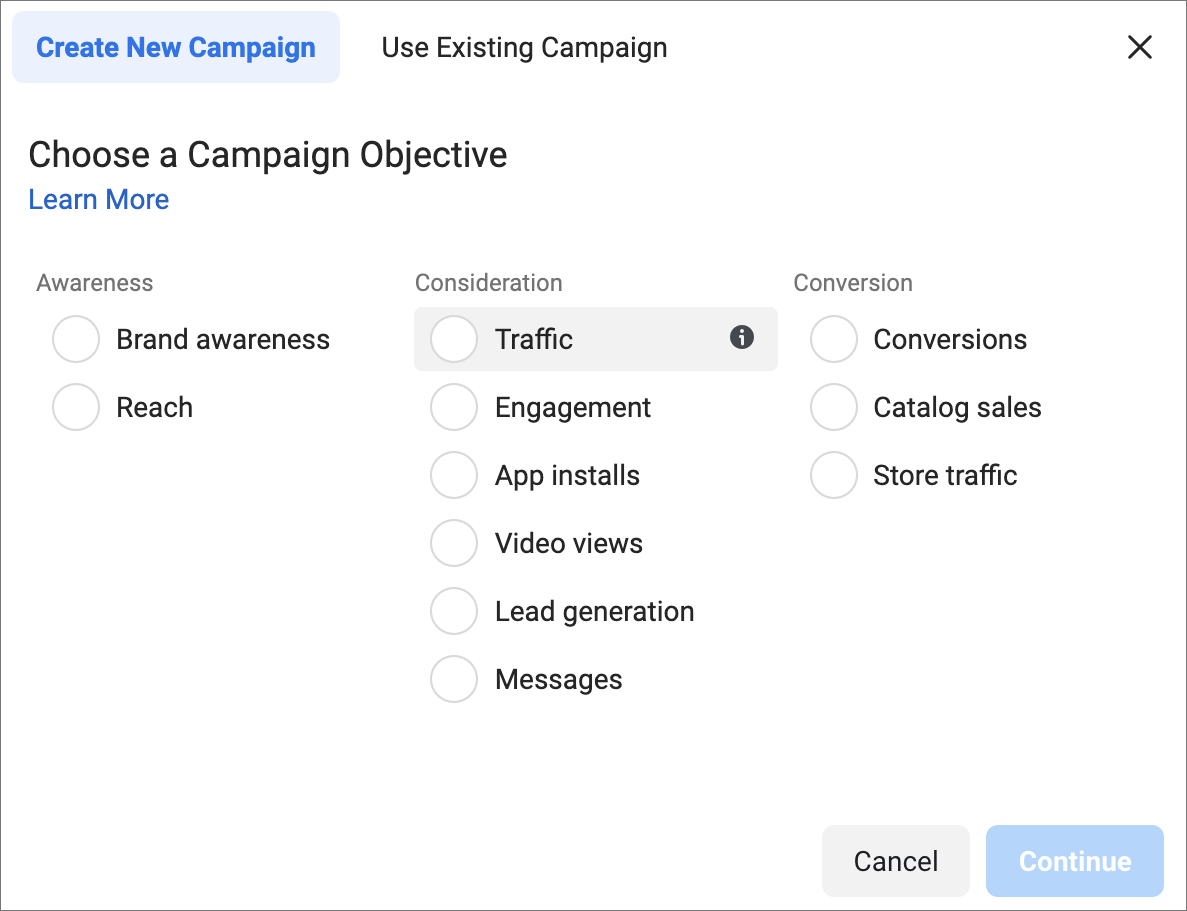
Why?
Our goal is to build an audience. Your audience should be active and engage with your brand. We aren’t interested in selling or getting emails at this time. Engagement with your ads means you are creating the right content and showing it to the right people. That is exactly what we want.
Engagement includes the following:
- Likes
- Comments
- Shares
Once you select engagement, you’ll get more options to specify the type of engagement. The options are Post engagement, Page likes, and Event responses.
This is the first area where you can experiment between Post engagement and Page likes. Both will validate that you are reaching the right people.
Finally, give your campaign a descriptive name.

Click on continue to go to the next step. Facebook will create an Ad Set and an Ad for you.
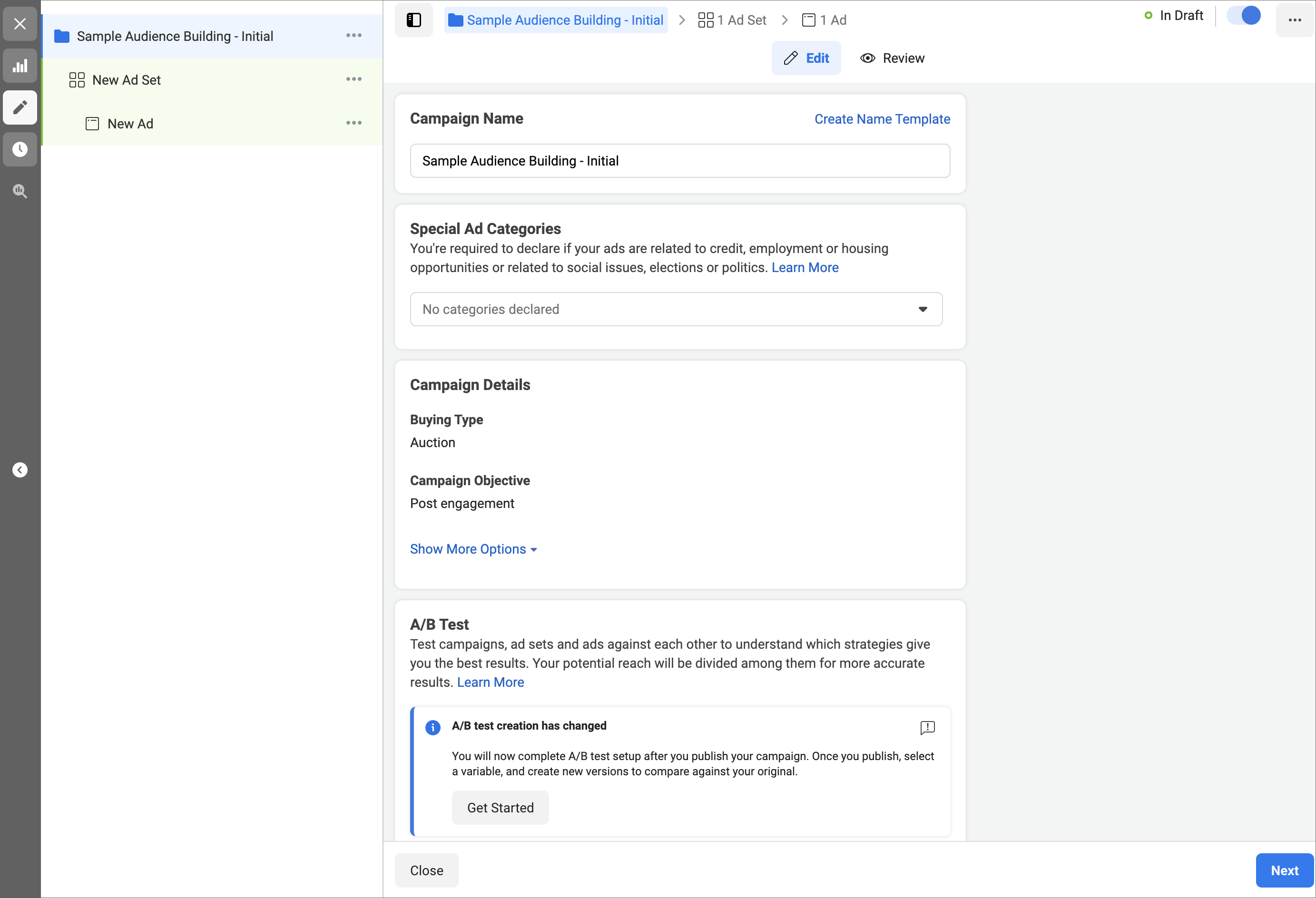
You don’t need to do anything else for the campaign. We aren’t doing political advertising or asking for personal information.
Define Your Ad Set
The Ad Set defines your budget, start and end date, ad placement, and most importantly your audience.
Give your ad set a descriptive name about the target audience. Remember, your first one will be broad. As you gain an understanding of your audience you will begin to get more specific. You want to make sure to create different ad sets for them.
Set your daily budget. Facebook defaults are usually pretty good to start. You can create a new ad set with a different spend if it works well, but that is a more advanced topic than this.

Pay attention to the audience meter to the right. In the screenshot above it is basically everyone in the US. We haven’t defined an audience yet.
TIP: Set your ads to start at midnight. This provides a full day of running ads and will provide the most realistic results.
Create Your Ad Set Audience
This step is the one where you will be spending most of your time and testing from an ad perspective. Your copy and creative are important but are separate from the ad setup.
A broad part of the audience is the 3 basic demographic information: Location, Age, and Gender. These are the first updates that you should make.
Location
Target locations that make sense. You’ll have several options here in a dropdown. Depending on your business you may benefit from the options in the dropdown. Most likely the default will work best.
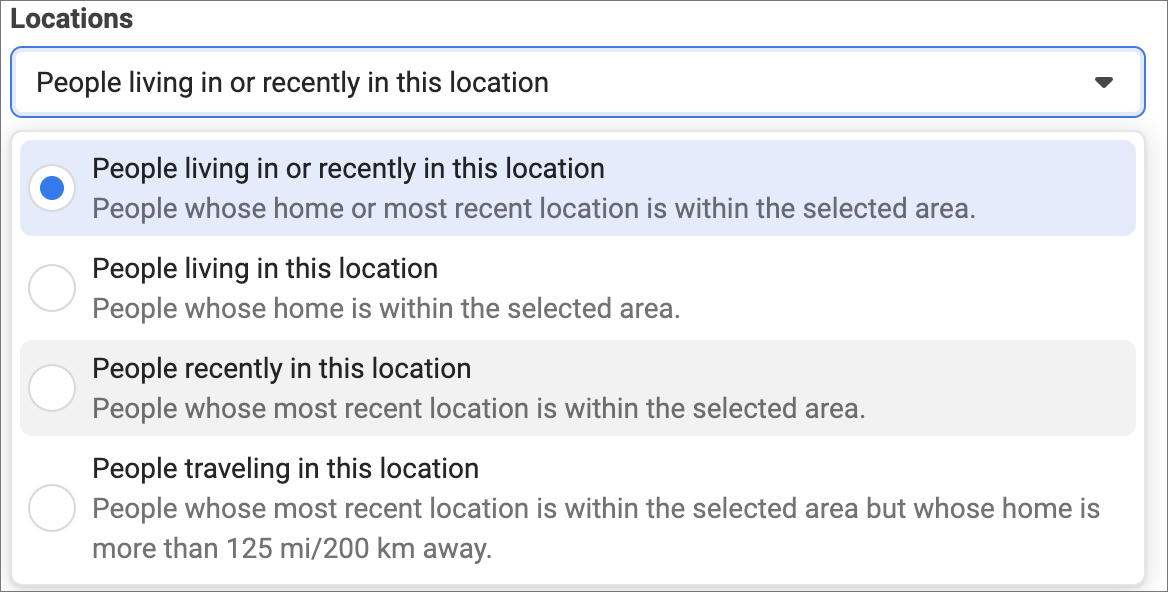
You have a lot of options for location. For example. you can take only cities within a country. You can also specify only cities between certain populations. By targeting only cities in the US, our target audience has been reduced by over 50%.
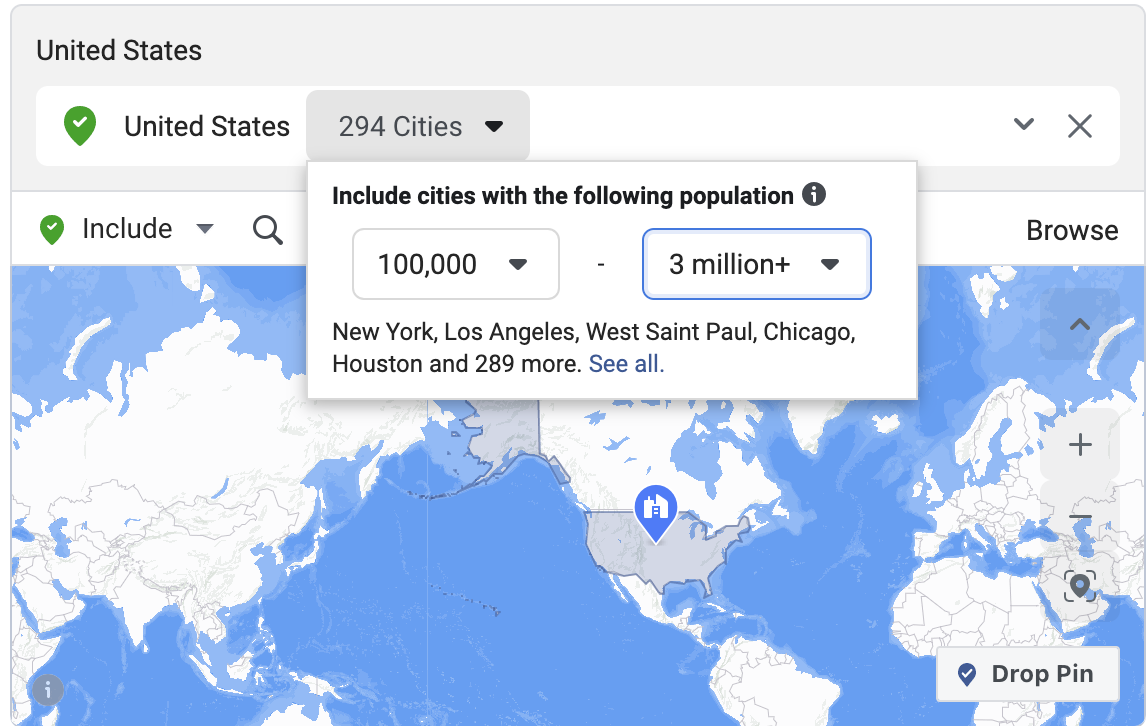
Gender
If your product or service is geared towards a specific gender, target that gender.
Age
Lastly, provide a reasonable age range. Try to be specific in this area and don’t leave it for the entire age range. Limit it to who you think your primary customers are.
Here is our result with just working on the 3 different demographic data.
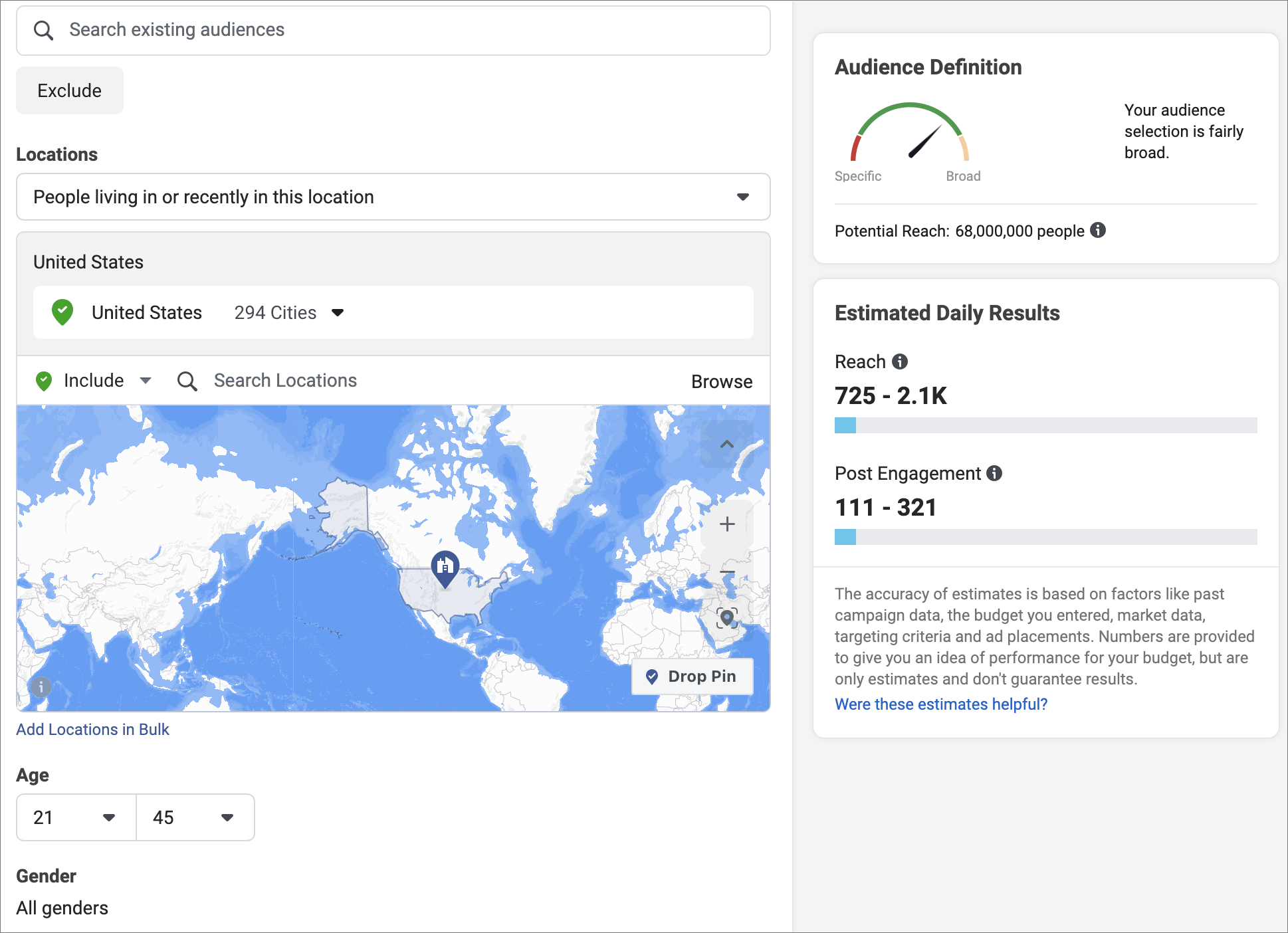
Interest Targeting
This is where you are going to spend most of your time testing to find your audience and segments. Being able to target based on interests is extremely powerful. The more refined your audience the better your results will be.
Let’s assume you are selling organic beauty supplies. You would want to start to target obvious audiences. Below the demographic information in the ad set, you’ll see detailed targeting. This is where the fun happens. You can add more demographic data as well such as income level or education.
TIP: You want to narrow your audience. The UI displayed will be additive instead of restrictive. Make sure to click on narrow to add interests that will be required as an AND.
So taking a broad guess at who would be interested in organic beauty supplies:
- College Graduate.
- Top 10% of Income In Zip Code.
- Environmental Protection interest
- Sustainability interest
By narrowing our audience our audience is now about 700,000 people. This is still broad but will let us know we are heading in the right direction.
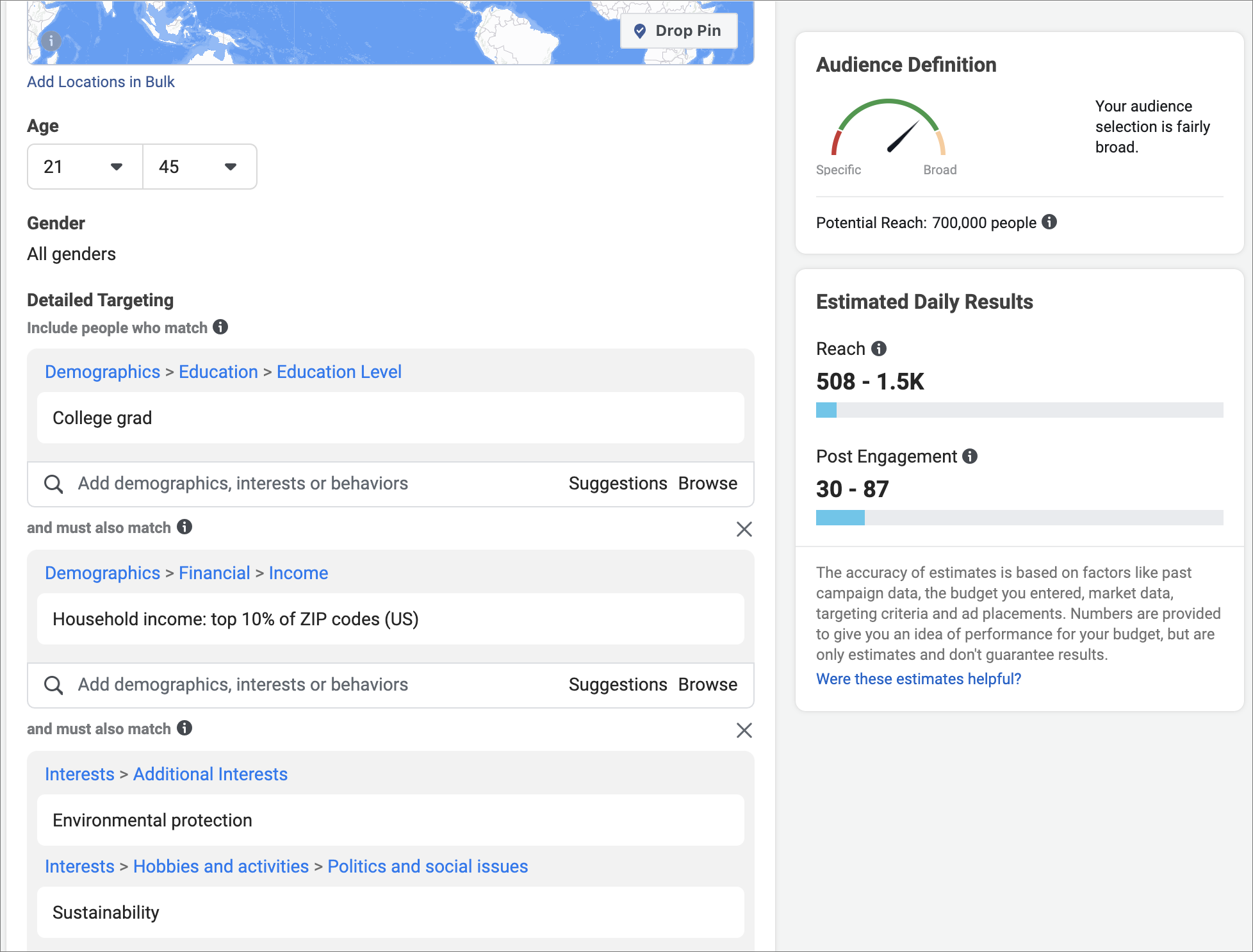
TIP: When looking at interests Facebook will give you an estimate of the number of people that have that interest and a description in a tooltip.

You can then save this audience and go to creating the ad itself.
Refine Your Audience
Continuing without organic beauty supplies example, you can refine your Facebook audiences even further. By doing so you will gain a deeper understanding of both your messaging and what your audience is interested in.
For example, maybe people that are interested in organic beauty supplies are also interested in other sustainability efforts. You can test an audience interested in electric vehicles. Or perhaps more specifically people interested in Tesla.
You can also exclude interests for your audience. For example, you could potentially exclude people interested in or working at Exxon.
Keep testing different hypotheses about your audience and testing the results. As you do so, you will begin to develop your audience and segments within your audience. With all this data you can create content specifically for your audience and ads that will convert.
Summary
We’ve shown how you can find your audience using Facebook Ads. It is an effective and cost-effective way to do research and get immediate feedback. Keep testing even as you refine your audience. Nothing is static, including your customers.
If you’d prefer to have someone run and manage your paid advertising just say the word and we’ll be happy to help.